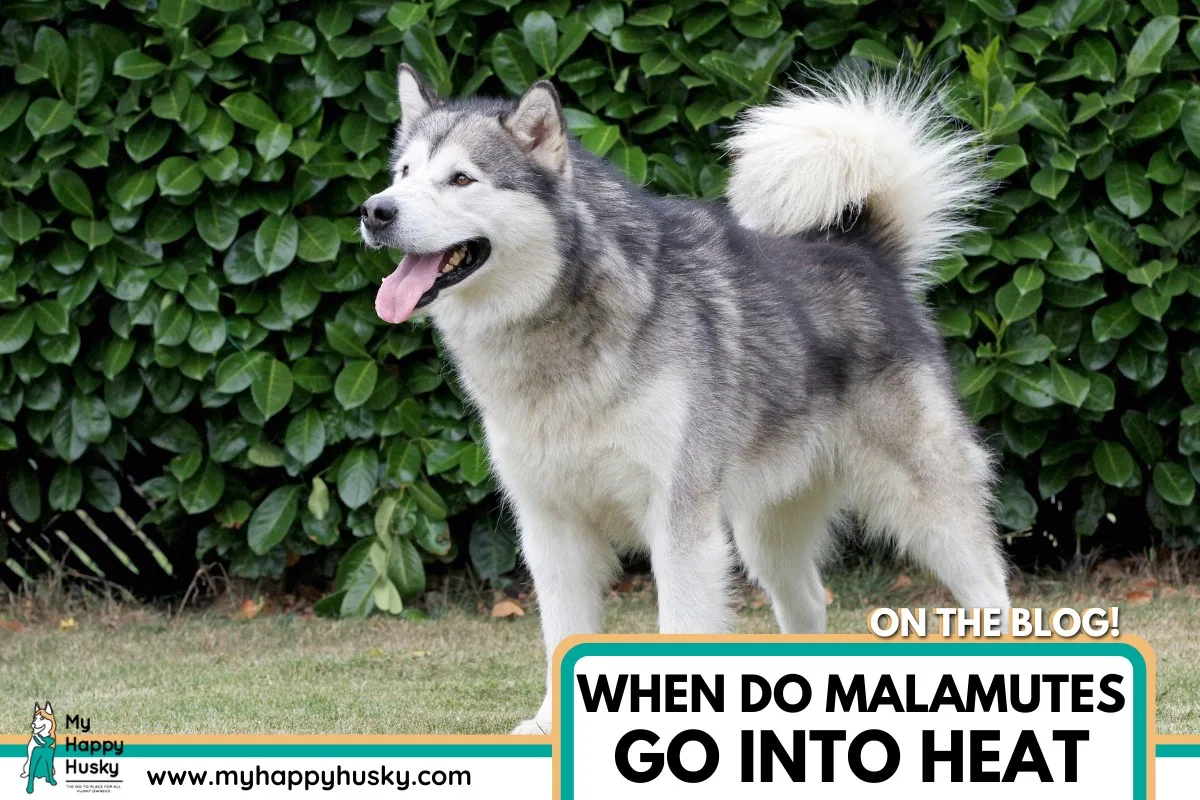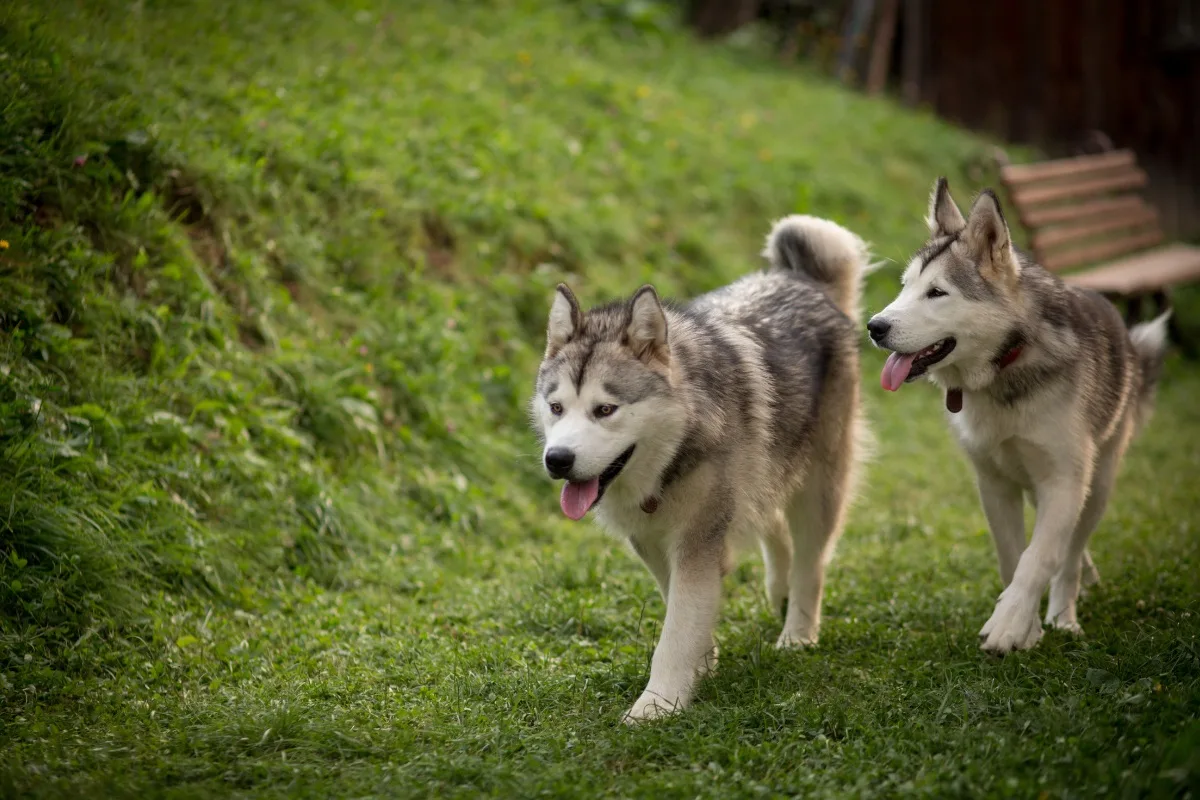Knowing when your Malamute will go into heat may not be obvious, and many owners understandably have many questions on this topic.
This article clarifies everything and covers the most commonly asked questions surrounding Malamutes and their heat cycles.
This article explains:
- When Malamutes go into heat
- The signs to look out for
- How long Malamutes stay in heat
- How often heat cycles occur
- The four different stages of each heat cycle
- How to care for your Malamute in heat
- Breeding questions
Let’s get into it!

When Do Malamutes Have Their First Heat Cycle
The majority of Malamutes will experience their first heat between 10 to 14 months of age, however, this timeframe may vary, and it’s considered normal.
Some Malamutes may enter their first heat as early as 6-8 months, while others might not experience it until 18 months of age.
It’s important to note that there’s no fixed timeline for every Malamute.
While most Malamutes have their first heat within the 10 to 14-month range, it’s not universal.
Signs Your Malamute Is Going Into Heat
What are the indications that your Malamute is going into heat? This is the next most common inquiry. Let’s delve into it!
➡️ These are the signs your Malamute is going into heat:
● Bleeding or small blood spots
● Discharge
● Swollen vulva
● Paying attention to her genitalia
● Increased urination
● Increased attention to her genital area
● Aggression towards male dogs
● Changes in usual behavior
● Changes in energy
● Changes in appetite
● Tail covering vulva
Just like with timing, the signs may vary, and some Malamutes will exhibit specific signs more prominently than others. Some may experience significant bleeding, while others may show no signs of bleeding at all!
However, most females WILL show at least one or two of the most common primary signs: bleeding, discharge, a swollen vulva, or an increased focus on their genital area.
Observing your Malamute carefully on a daily basis will help you notice any changes in their behavior sooner rather than later. And that’s the key!
How Long Are Malamutes In Heat
Malamutes typically stay in heat for approximately 3 weeks (21 days), give or take a few days on either side.
During the first 8-10 days, your Malamute won’t be interested in mating, and in the last 8-10 days, she’ll be ready and able to conceive.
While there are technically four stages (as explained below), the first two are the most significant and constitute the time frame when we consider a Malamute to be in heat.
How Often Do Malamutes Go Into Heat
For most large dogs like malamutes, two heat cycles per year is the standard.
However, some extra-large malamutes are known to experience just one heat cycle every 10-12 months.
Usually, the large the dog, the less frequent their heat cycles are.
Still, each malamute is different, and various factors like genetics, diet, and lifestyle can all influence heat cycle frequency.

The Four Stages to Each Heat Cycle
There are four stages to your Malamute’s heat cycle, and each stage means something different.
It’s crucial to be aware of what is happening during each stage since your Malamute will exhibit different signs, depending on which stage she is in.
1. Proestrus Stage
The first stage, proestrus, usually lasts between 8-10 days. During this stage, your Malamute’s body will prepare to mate and conceive, but she WILL NOT want to mate. Expect her to be aggressive towards males to keep them away.
Most Malamutes have a proestrus stage that lasts between 8-10 days, but this can vary by a few days.
➡️ Signs of the proestrus stage:
● Swollen vulva
● Bleeding
● Discharge
● Licking of the genital area
● Tail tucking
● Aggression toward males
2. Estrus Stage
Next is the estrus stage, when your Malamute is fertile and ready to mate. She will be receptive towards males and may hold her tail to the side when any are nearby. Expect her to urinate more and potentially be aggressive towards females.
Most Malamutes have an estrus stage that lasts between 8-10 days, but this can vary by a few days.
➡️ Signs of the estrus stage:
● Frequent urination
● Holding tail to the side
● Will accept males
● Can be aggressive towards females
● Discharge might change color, consistency, or slow down
3. Diestrus Stage
Following the estrus stage is diestrus, when your Malamute’s body returns to normal. If your Malamute has not been impregnated, this stage will last around 7 days after the estrus stage. However, if she has been impregnated, this stage will last for the duration of the 60-70 days until the birth happens.
➡️ Signs of the diestrus stage:
● Vulva will return to normal size in around 7-10 days
● Discharge will also reduce until stopping completely
4. Anestrus Stage
Finally, the anestrus stage is the resting stage. Your Malamute will remain in this stage until the entire heat cycle starts again from the proestrus stage.
Caring For a Malamute In Heat
Being prepared for when your malamute goes into heat all comes down to timing. If you know the signs to look out for (as listed above), you’ll have the time to be prepared.
Here are some of the best tips we know that will help you care for your malamute when she’s near, and in, her heat cycle.
1. Avoid letting her outside in the yard alone
Believe it or not, males will be able to smell your malamute entering into heat from many miles away and will encourage them to reach her. It’s no exaggeration to say that some males would do all they can to enter your yard.
Additionally, once your malamute is in her estrus stage, she herself might try escaping in order to find a partner. Always supervise her outside. Ideally, use a leash, even for potty breaks.
2. Always use the leash when she’s in heat
Whether you’re going for a walk or letting her outside in the yard for a potty break, using the leash is a must. When she herself is IN heat, the chances of her running off or escaping are very high. This happens much more than owners think. Please don’t take that risk.
3. Be accepting of her mood swings
All malamutes will react differently, some exhibit extra clinginess, and some will resort to nesting behavior and want to stay in their bed. Whatever it is, know that it’s only temporary and will pass.
Additionally, there’s a strong chance she will have dramatic mood swings and character changes so ensure the family knows that all of this is normal. Be comforting when she desires comfort and give her space when she seeks it.
4. Schedule a vet check-up
To remain on the safe side, it’s a good idea to visit your veterinarian for them to make an assessment and confirm everything is ok.
Remember, there’s nothing wrong with consulting your veterinarian, even if nothing appears to be wrong.
There are some known health implications that could happen after the heat cycle, so it’s worth contacting your veterinarian as a precautionary measure.
5. Be ready for the extra mess
From the bleeding, discharge, and increase in urination, it’s going to be a little messy. Be READY for that with extra towels protecting your floors, and other areas your malamute usually goes.
Many owners resort to keeping their malamute in one single room (due to the mess) but, ideally, if you take enough action beforehand, it will be more comfortable for your malamute if she has the usual roam she normally does.
6. Keep her bed as clean as possible
Similar to above, her bed and sleeping area will also get quite messy and it’s advised to keep this as clean as possible. Whether this means washing the bed or switching it over on a daily basis, it’s best to reduce bacteria build-up where possible.
7. Consider hygiene pants
Hygiene pants or “doggy diapers” are a great way to keep the mess at bay as well as preventing unwanted pregnancy for when your malamute is out on walks. Some dogs take to these pants and others hate them, but they are certainly worth trying. Most have replaceable pads inside.
Best Time to Breed Malamutes
Technically, a Malamute can start breeding whenever their first heat cycle comes, but this is not recommended.
It is safer to wait until the malamute is fully mature, typically between 2-3 years of age. Some like to wait until the dog has had 2 or 3 heat cycle before breeding, which usually results in reaching a similar age like 2-3 years.
So why is important to wait?
When a Malamute is bred too young, they are more likely to have complications during pregnancy and birth.
This can include issues such as premature labor, small litters, and even stillbirths. Additionally, breeding a Malamute before they are fully developed can lead to health problems in the puppies, including developmental issues and poor immune systems.
These issues can significantly impact the health and wellbeing of both the mother and the puppies.
It is also important to consider the temperament and genetic health of the Malamute before breeding. Responsible breeders will ensure that both parents are healthy, have good temperaments, and do not carry any genetic diseases or disorders.
This helps to ensure that the puppies are healthy and well-adjusted.
More Malamute Articles
Disclaimer
The advice given in this article is for educational purposes only and does not constitute professional advice in any context. Before making any decisions that may affect the health and/or safety of your dog, you should always consult a trained veterinarian in your local area. For the FULL disclaimer Visit HereCopyright Notice: The content produced and published on My Happy Husky is unique and original. My Happy Husky makes an active effort to search for plagiarized content using plagiarism detection software. If plagiarized content is found, action will be taken.
